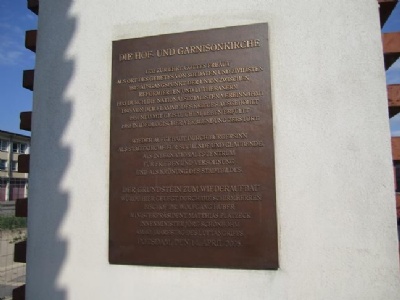Potsdam – Garnisonkirche
After the parliamentary elections on March5, 1933, the Nazis got almost 44 percent of the votes, but still not enough to get a majority in the parliament. The Nazis were the largest party, however, the Reichtag fire in late February 1933 and the subsequent arrests of political opponents meant that Hitler could control the development in a way that was favourable for him.
In a mutual decision between president Hindenburg and Hitler the Reichtag opening would take place in Potsdam garrison church. The date March 21, was carefully chosen cause it was the same date that the first parliament had been proclaimed by the united Germany’s first Chancellor, Otto von Bismarck. Propaganda minister, Josef Goebbels, was commissioned by Hitler to take full advantage of the event. Goebbels called it Potsdam Day and it would be the starting point for the new Germany whose future was based on the greatness of the old Germany.
The garrison church had been built by the Prussian kings in the early 1700s and thus linked Prussia with the Christian traditions. Both Frederick I and II (great) were buried in the crypt of the church. With this background, it is not difficult to understand why the Nazis were keen to conduct the ceremony at Potsdam. At the opening, Hindenburg was dressed in a Prussian field marshal’s uniform and was the central figure of the opening. Hindenburg was considered to be the link between the old deposed monarch, Wilhelm II, and Germany’s new chancellor, Adolf Hitler.
Hitler was dressed in a black suit and took the role of a subordinate servant. This would symbolize a national reawakening through a union of the old (Hindenburg) with the new (Hitler). After opening, Hindenburg received a military parade conducted by the army, SA, SS and Stahlhelm. During the parade, Hitler and his henchmen stood at a distance behind Hindenburg. Two days later when the parliament opened in Krolloper and in Hindenburg’s absence, there was no doubt who was the new master. The church was badly damaged in the final stages of the war and the ruins were demolished in the late sixties.
Current status: Demolished with monument (2011).
Address: Breite Strasse 7, 14467 Potsdam.
Get there: Car.
Follow up in books: Kershaw, Ian: Hitler – A Biography (2008).


In 2008 there was a discussion about whether the church should be rebuilt but it is a bit controversial. Not only because the Nazis used the church for their purposes in march 1933, but also because the church with its connection to the Prussian military traditions once again becomes a symbol of militarism.